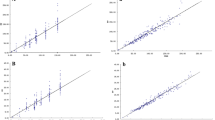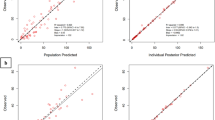Abstract
This study aimed to perform a pharmacokinetic-pharmacodynamic (PK-PD) target attainment analysis to create a dosing strategy for cefozopran in Japanese adult patients. A total of 145 plasma concentration samples from 32 adult patients were used for a population pharmacokinetic modeling and Monte Carlo simulation to assess the probability of attaining the PK-PD target (70% of the time above the minimum inhibitory concentration for the bacterium). The final population pharmacokinetic model was based on a two-compartment model, and creatinine clearance (Clcr) and body weight (BW) were the most significant covariates: Cl(l/h) = 0.0263 × Clcr + 1.49, V c(l) = 0.185 × BW0.931, Q(l/h) = 4.55, V p(l) = 5.86, where Cl is the clearance, V c is the volume of distribution of the central compartment, Q is the intercompartmental clearance, and V p is the volume of distribution of the peripheral compartment. The Monte Carlo simulation demonstrated that 1 g q 12 h achieved a PK-PD target attainment probability of ≥85% against Escherichia coli, Klebsiella pneumoniae, and Streptococcus pneumoniae isolates. However, against Haemophilus influenzae and Pseudomonas aeruginosa isolates, 1 g q 8 h and (2 g, 1 g, 1 g) q 8 h were required to achieve a high probability, which value varied with the Clcr and BW of the patient. These results provide a PK-PD-based strategy for tailoring cefozopran regimens in Japanese adult patients.
Similar content being viewed by others
References
Kobayashi H, Moritono S, Hara K. Significant role of new cephem antibiotics: focused on cefozopran. Jpn J Antibiot 1997;50:807–820.
Drusano GL, Preston SL, Hardalo C, Hare R, Banfield C, Andes D, et al. Use of preclinical data for selection of a phase II/III dose for evernimicin and identification of a preclinical MIC breakpoint. Antimicrob Agents Chemother 2001;45:13–22.
Tam VH, Louie A, Lomaestro BM, Drusano GL. Integration of population pharmacokinetics, a pharmacodynamic target, and microbiologic surveillance data to generate a rational empiric dosing strategy for cefepime against Pseudomonas aeruginosa. Pharmacotherapy 2003;23:291–295.
Ludwig E, Konkoly-Thege M, Kuti JL, Nicolau DP. Optimising antibiotic dosing regimens based on pharmacodynamic target attainment against Pseudomonas aeruginosa collected in Hungarian hospitals. Int J Antimicrob Agents 2006;28:433–438.
Eagye KJ, Kuti JL, Dowzicky M, Nicolau DP. Empiric therapy for secondary peritonitis: a pharmacodynamic analysis of cefepime, ceftazidime, ceftriaxone, imipenem, levofloxacin, piperacillin/tazobactam, and tigecycline using Monte Carlo simulation. Clin Ther 2007;29:889–899.
Paulfeuerborn W, Muller HJ, Borner K, Koeppe P, Lode H. Comparative pharmacokinetics and serum bactericidal activities of SCE-2787 and ceftazidime. Antimicrob Agents Chemother 1993;37:1835–1841.
Yamamoto T, Adachi Y, Nagamine Y, Suwa M, Nanno T. Clinical phase I study of cefozopran. Shinryou To Shinyaku (Treat New Med) 1993;30:281–304.
Higashiyama Y, Yamashita Y, Mitsutake K, Matsuda H, Miyazaki Y, Tanaka K, et al. Laboratory and clinical studies on cefozopran. Jpn J Chemother 1993;41:233–244.
Katayama Y, Yamashita Y, Kumon H, Kaku S. Transfer of cefozopran into the prostate tissues. Jpn J Chemother 1993;41:158–163.
Tanimura H, Nakai T, Takifuji K, Shimomura T, Okamura T, Ono K, et al. Pharmacokinetics and clinical effect of cefozopran in surgical infections. Jpn J Chemother 1993;41:373–383.
Yafune A, Naito H, Takebe M. Population pharmacokinetic approach with Monte Carlo integration for clinical phase I trial of pilocarpine HCl tablet. Jpn J Clin Pharmacol Ther 1999;30:423–433.
Craig WA. Interrelationship between pharmacokinetics and pharmacodynamics in determining dosage regimens for broad-spectrum cephalosporins. Diagn Microbiol Infect Dis 1995;22:89–96.
Burgess DS, Frei CR. Comparison of beta-lactam regimens for the treatment of gram-negative pulmonary infections in the intensive care unit based on pharmacokinetics/pharmacodynamics. J Antimicrob Chemother 2005;56:893–898.
Nomura K, Morikawa N, Ikawa K, Ikeda K, Fujimoto Y, Shimizu D, et al. Optimized dosage and frequency of cefozopran for patients with febrile neutropenia based on population pharmacokinetic and pharmacodynamic analysis. J Antimicrob Chemother 2008. doi:10.1093/jac/dkn038.
Ikawa K, Morikawa N, Matsuda S, Ikeda K, Ohge H, Sueda T. Peritoneal penetration and pharmacodynamic exposure of intravenous cefozopran in abdominal surgery patients. Int J Antimicrob Agents 2007;30:352–355.
Ikeda K, Morikawa N, Kuribayashi M, Ikawa K, Nomura K, Taniwaki M. Real-time therapeutic drug monitoring of cefozopran in plasma using high-performance liquid chromatography with ultraviolet detection. J Pharm Biomed Anal 2007;45:811–816.
Yamaguchi K, Ishii Y, Iwata M, Watanabe N, Uehara N, Yasujima M, et al. Nationwide surveillance of parenteral antibiotics containing meropenem activities against clinically isolated strains in 2004. Jpn J Antibiot 2005;58:655–689.
Kondo T, Yoshida K, Tanayama S. Metabolic fate of cefozopran hydrochloride, a new broad-spectrum cephalosporin, in rats and dogs. Jpn J Chemother 1993;41:81–95.
Mouton JW, Dudley MN, Cars O, Derendorf H, Drusano GL. Standardization of pharmacokinetic/pharmacodynamic (PK/PD) terminology for anti-infective drugs: an update. J Antimicrob Chemother 2005;55:601–607.
Ariano RE, Nyhlén A, Donnelly JP, Sitar DS, Harding GK, Zelenitsky SA. Pharmacokinetics and pharmacodynamics of meropenem in febrile neutropenic patients with bacteremia. Ann Pharmacother 2005;39:32–38.
Takenaka T, Watanabe T, Hayashi T, Hata K, Ono N, Kumon H, et al. Pharmacokinetics and dosage planning of cefozopran in patients with renal insufficiency. Jpn J Chemother 1993;41:147–153.
Kanimoto Y, Takahashi M, Gouhara S, Okada K. Pharmacokinetics of cefozopran in the aged patients. Jpn J Chemother 1993;41:154–157.
Sakurai Y, Hishikawa T, Hiramatsu N, Sagara Y, Kuwahara M, Nagasaki M, et al. Pharmacokinetic analysis of cefozopran in neonatal infections — population pharmacokinetics using NONMEM. Jpn J Antibiot 1999;52:16–23.
Li C, Kuti JL, Nightingale CH, Nicolau DP. Population pharmacokinetic analysis and dosing regimen optimization of meropenem in adult patients. J Clin Pharmacol 2006;46:1171–1178.
Bhavnani SM, Hammel JP, Cirincione BB, Wikler MA, Ambrose PG. Use of pharmacokinetic-pharmacodynamic target attainment analyses to support phase 2 and 3 dosing strategies for doripenem. Antimicrob Agents Chemother 2005;49:3944–3947.
Author information
Authors and Affiliations
Corresponding author
About this article
Cite this article
Ikawa, K., Nomura, K., Morikawa, N. et al. Pharmacokinetic-pharmacodynamic target attainment analysis of cefozopran in Japanese adult patients. J Infect Chemother 14, 130–136 (2008). https://doi.org/10.1007/s10156-008-0589-0
Received:
Accepted:
Published:
Issue Date:
DOI: https://doi.org/10.1007/s10156-008-0589-0




